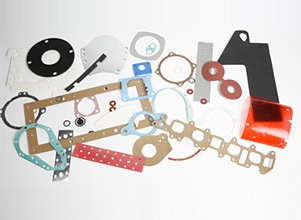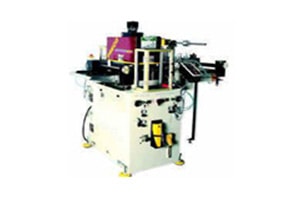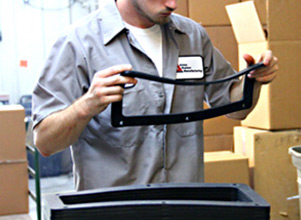Die Cutting
Ames Rubber Manufacturing has over sixty years of experience in the manufacturing of precision die cut gaskets, seals, and other die cut rubber products for a wide range of industries and applications.
We understand our clients’ needs when it comes to custom gasket design and fabrication. Here are a few more reasons why people turn to us for die cut gaskets:
- Cost-effective: We offer competitive prices and fast quoting.
- Quick turn-around times: Our automatic die-cutting equipment enables us to create high volumes within a short amount of time.
- Custom die cut gaskets: We can create custom-designed die cut gaskets according to your specifications.
- Technical expertise: Our experienced staff is here to give you technical assistance for all gasket and sealing applications.
- Prototype to Production: We can cut in quantities from prototypes and short runs to large production runs.
Concept to Completion
We offer die cutting services from concept to completion. Just send us a print or provide a sample and we will do the rest. We can provide new steel rule die tooling or utilize your existing steel rule die or hardened tool. Next we choose the ideal cutting process for your application, and finally we can advise you of material options when available. Let Ames Rubber Manufacturing be a one stop solution for your die cut gasket needs.
Considerations For Cutting Gaskets & Pads
Ames Rubber Manufacturing looks at many variables when quoting on your requirements.
Part Geometry – Parts with thin walls, or other difficult angles may not die cut well and may require Class A hardened steel tooling, water jet cutting, lathe cutting, or molding.
Material Type – Certain materials are susceptible to deformation – which may or may not be acceptable depending on the particular application.
Material Thickness & Hardness or Density – The thickness in conjunction with the Durometer plays a significant role in how well the material will cut or if it can be die cut at all.
Tolerances – Because of the nature of rubber and other flexible materials, tolerances need to be “looser” than sheet metal tolerances. Parts requiring extremely tight tolerances may need class A hardened steel tooling or water jet cutting vs. steel rule cutting.
Is a “Kiss Cut” required? – Kiss cutting is the process of compressing the die blade, carefully cutting the gasket material into, but not through, the adhesive liner allowing for “peel & stick” applications. Once parts are kiss cut they are wound on a roll for shipment.
Volume – We have a die cutting process to match your need from prototype quantities to Larger volumes. Tooling options can also directly affect the cost based on volume. Packing and Shipping Method – Typically manufacturing cells prefer parts to be packed in a certain fashion whether the parts are in roll form, cut through, on strip, etc…Considering the packing method before the final design can contribute to significant cost saving in manufacturing time.
Steel Rule Dies – All steel rule dies are cut with a high accuracy CNC laser. This produces tooling that can hold tolerances as close as .005″. Single and multiple cavity dies are available. Dies are made to order from prints or reverse engineered from samples.
Which Die Cutting Method Should I Choose?
We utilize several different methods of die cutting to give our customers options based on volume and part geometry ensuring reduced costs and increased customer satisfaction.
High speed and High volumes favor our Preco® Die Cutting Presses
Our State of the art Preco® high speed programmable cutting equipment allows for economical higher volume production runs, with precision accuracy.
Advantages:
- Fast, most cost effective means of cutting relatively thin parts
- Cutting capacity is up to 12” x 20”
- Faster set-up and increased accuracy wastes less time and materials
- Memory storage for quick response to reorders
- Works with materials in strip, sheet or roll format
- Kiss cut, cut-through or combination applications
- Precise tolerances are achieved in both cutting depth and overall part geometry
Larger Parts May Require Our Traveling Head Beam Presses
Parts that are typically cut on our traveling head presses are usually larger in size, where materials can be pulled through the cutting area on full rolls.
Advantages:
- Minimal setup time.
- Cost effective for low volume runs of large die cut gaskets
- Gaskets can be cut as large as 20” wide x 75” long
Lower Volumes and Medium Size Parts May Require Our Hytronic Clicker Presses
Parts that are typically cut on “clicker” presses are similar to those cut on Preco® units (small to mid-sized die cut gaskets), but at lower volumes.
Advantages:
- Cost effective for low volume runs of small die cut gaskets
- Minimal setup time.
Solutions by Function
Gaskets can also be grouped into different types by their functions or uses. Some of the most common uses of gaskets are:
Liquid Seals – One of the main functions of a gasket is to seal against the leak or ingress of liquids. The rubber in liquid seals should be specified to the liquids used in the process. Certain polymer types offer better resistance to chemicals, such as Viton®, whereas Nitrile is more suited to industries involving oils, fuels and solvents.
Environmental Seals – Environmental seals guard against dust and other environmental contaminants. These seals are used in enclosures, such as electrical enclosures. Enclosures the world over have requirements for access for maintenance.
Anti-Vibration – Vibration, as with sound, has frequencies. Anti-vibration pads are a way of disrupting those frequencies and reducing the amount of energy wasted or damage caused by vibration. Anti-vibration methods are used in area such as machinery mountings, pipe supports and structural bearings.
Mountings – With technology today involving more digital displays to provide information, equipment manufacturers need to protect the sensitive display units from shock, ingress of dust or other particles that may include dust, environmental contaminants or liquids.
The right material for the job:
- EPDM Rubber & Sponge
- Neoprene Rubber & Sponge
- Silicone Rubber & Sponge
- Viton® Rubber
- Red Rubber
- Pure Gum Natural Rubber
- Cloth Inserted Rubber
- Diaphragm Sheet
- FishPaper
- Garlock Sheet
- Vellumoid (Vegetable Fiber)
- Cork, Cork & Rubber
- SAE Industrial Felt Products
- Compressed Non-Asbestos
- Nitrile Rubber & Sponge
- SBR Rubber & Sponge
- Blended Elastomer Sponge
- Flexible Graphite
- Latex – Isoprene Rubber
- Precision Plastics; Mylar®, PVC, Kapton®, Sintra®, Lexan®. Polyethylenes- UHMW, HDPE, LDPE, Polypropylene
- Polyurethane
- Sponge Rubber – Open & Closed Cell
- PTFE
- Butyl
- Paper and Paperboard Products
Gasket Thickness for Compressed Materials
When choosing the gasket thickness for compressed materials, remember that thinner is better. Most compressed sheet gasketing sealing values are based on 1/16” thickness. Thicker materials require a greater compressive force to seal and have lower pressure ratings. The use of 1/16” thick gaskets will provide better sealing with lower bolt loading than 1/8” thick gaskets. So thinner is usually not only more cost effective, Thinner works better!
Solutions by Item
- Die cut adhesive gaskets
- Die Cut anti-vibration pads
- Die cut bezel gaskets
- Die cut case gaskets
- Die cut EMI/RFI shielding gaskets
- Die cut enclosure gaskets
- Die cut LCD gaskets
- Die cut mounting gaskets
- Die Cut Pipe gaskets
- Die cut shims and spacers
Solutions by Industry
- Aerospace & Aviation
- Automotive and Trucking
- Electronics
- Filtration
- Fluid Transfer
- Food & Beverage
- General Industrial
- Medical & Pharmaceutical
- Packaging and Container Accessories
- Plumbing/Potable Water
- Power Transmission
- Robotics




